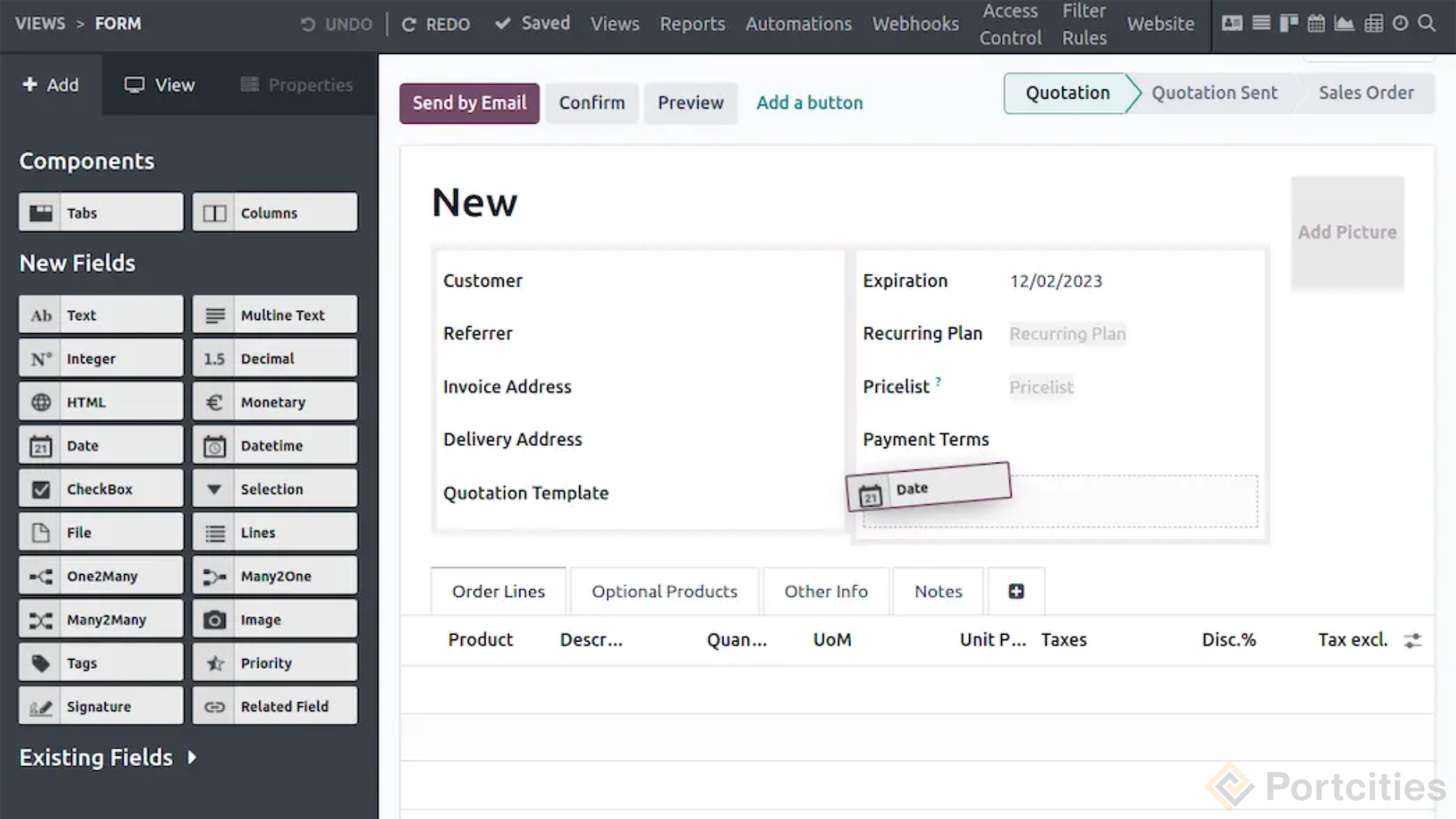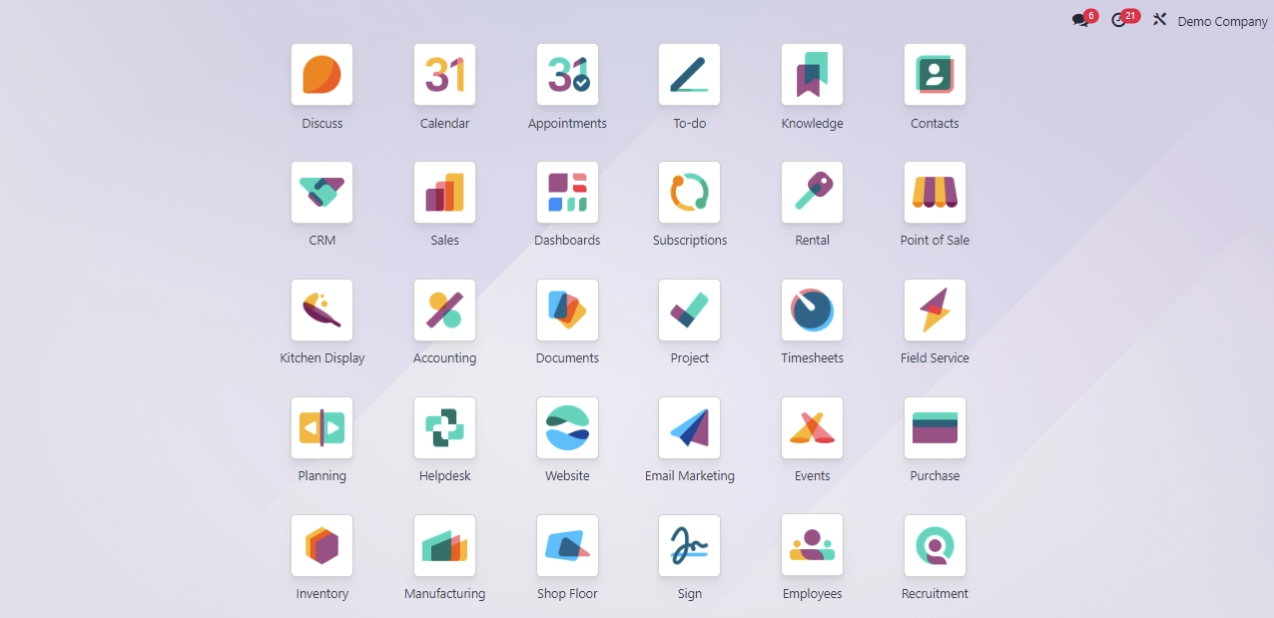If you already know what ERP and CRM are, and you decided to do more research on Odoo, then you are in the right place.
Now that you have the foundation, let’s explore Odoo—an open-source business management platform that combines ERP and CRM functionalities seamlessly.
Whether you’re a small startup or a large enterprise, Odoo offers a modular approach, allowing you to pick and choose the features that align with your needs.
Without further ado, let’s get up close and personal with Odoo!
What is Odoo?
In (very short) summary, Odoo ERP and CRM is a comprehensive suite of applications designed to cover all aspects of business management.
The long version: Odoo is an open-source ERP software that seamlessly integrates multiple business applications. Imagine it as a versatile toolkit where eCommerce, CRM, accounting, manufacturing, project management, and more come together. Whether you’re a growing startup or a seasoned enterprise, Odoo’s got your back.
The Belgian suite of business management software tools has an intriguing backstory.
Back in 2005 when Fabien Pinckaers, the visionary founder and current CEO, embarked on a software journey. Back then, his brainchild was affectionately labeled TinyERP. Fast-forward to 2008, and the company underwent a name transformation, becoming OpenERP.
In 2014, having grown significantly, OpenERP donned its final moniker: Odoo. Why the name change? Well, Odoo wanted a brand free of restrictions.
Odoo’s Primary Features and How Can They Help Your Business
Now, you might be wondering about the features and how they could help your business.
Easy. Let us help you with that.
1. Inventory and Supply Chain Management
Imagine a large warehouse with multiple storage areas—shelves, aisles, cold storage rooms, and pallet racks. Keeping track of inventory across these locations can be challenging. Odoo allows you to create and manage specific storage locations, ensuring efficient organization and easy retrieval of products.
As new stock arrives, it’s crucial to place it in the right location. Odoo’s putaway rules automatically route products to ideal storage spots based on real-time capacity and product needs. This streamlines warehouse operations and minimizes errors.
Warehouse tasks—receiving, sorting, packing—are critical for smooth operations. Odoo helps manage these tasks efficiently. Additionally, smart removal strategies (such as FIFO or FEFO) optimize picker paths, ensuring timely order fulfillment.
Handling incoming shipments involves managing quantities, units of measure, and return conditions. Odoo simplifies this process by allowing you to set predefined routes for returns and update inventory valuation seamlessly.
Speaking of delivery, Odoo’s advanced route configuration enables custom routes for drop-shipping, cross-docking, and more. Plus, multi-warehouse capabilities facilitate smooth transfers between different locations.
2. Purchase Management
In purchasing, you probably realize that comparing vendor bills, managing purchase tenders, and tracking quality is essential.
Guess what?
An ERP like Odoo can do all of the above and more. The software is also equipped with currency rounding capacity that ensures accurate pricing and payments.
And if you have too much tasks and keep forgetting things, it also has an automated follow-up feature to help you pay your vendors on-time. So you’ll never have overdue payments and keep your cash flow healthy.
3. Point of Sales and Sales Management
Your sales teams need a modern interface to efficiently manage leads and convert them into sales orders. Odoo’s user-friendly interface and mobile capabilities empower salespeople—even when they are working on a client’s site.
We all can agree that manually entering data can be time-consuming. Good thing Odoo reduces data entry by allowing you to send quotes. The quotation builder ensures polished quotes with predefined products and templates. Automation also happens as you convert quotes to sales orders, and manage your sales pipeline – all in one place.
Whether at a retail store or a restaurant, Odoo’s intuitive point-of-sale interface ensures seamless service. Even in offline mode, transactions continue without data loss.
Wonder if there is a system that truly supports various payment methods (cash, checks, credit cards) while also providing a customer portal for order tracking and modifications? Odoo ticks all the boxes.
4. Finance and Accounting
Odoo Accounting adapts to any country’s requirements. Real-time reporting helps monitor financial performance instantly.
In the enterprise feature, Odoo allows you to access accounting features on iOS and Android devices. Odoo’s AI-powered invoice even allows digitization and automates the encoding of scanned PDFs.
5. E-Commerce and Website Integration
Integrating e-commerce platforms with robust enterprise resource planning (ERP) systems like Odoo offers several advantages. Real-time data synchronization for a seamless flow of information. Not to mention unified inventory management prevents overselling, streamlined order fulfillment reduces processing time, and personalized communication enhances customer experiences.
Not only do other Odoo modules integrate well with other third-party e-commerce platforms, but Odoo’s E-commerce module is more integrated with Odoo itself. The best part is that you can do so without needing a connector.
This integration creates a unified platform that streamlines business operations and enhances overall efficiency. By having a connected e-commerce transaction with inventory management, customer relationship management (CRM), accounting, marketing, and website functionalities, businesses achieve real-time synchronization, accurate stock counts, and optimized order fulfillment. Moreover, personalized communication based on customer data improves the overall e-shopping experience.
6. Manufacturing to Streamline Production Processes
Imagine a company like Textiles managing raw materials, labor, and machinery. In this scenario, input your manufacturing orders into Odoo, so you’ll have a well-defined manufacturing process.
You can also see that this feature can be useful in other types of industries. Like a food processing plant or manufactured goods. Odoo’s quality control features set standards, perform inspections, and manage non-conformities.
7. Customer Relationship Management (CRM) to build Strong Customer Relationship
Odoo centralizes customer data—interactions, preferences, and purchase history. For example, a retail chain can personalize its marketing campaigns based on individual preferences and data from CRM to secure customer retention.
To top it off, the ERP software streamlines lead tracking, opportunity management, and sales forecasting. A company can efficiently track leads from initial contact to deal closure.
8. Marketing Module for Targeted Campaigns and Brand Visibility
Want to increase their conversion rates? No problem.
Odoo 17 and its predecessors allow personalized email campaigns. Your store can use it to send tailored product recommendations to segmented customer groups.
Fun fact: Out of every 10 people who register for a webinar, approximately only 2 to 4 attendees are likely to show up for the event.
To mitigate this, Odoo has a powerful marketing automation process that triggers actions based on customer behavior. For instance, if your company holds an event, you can automate follow-ups after webinar registrations to ensure more than a 40% turnout rate on your event.
9. Events Module to Simplify Event Planning and Execution
Say you are a conference organizer. The Events module can streamline speaker coordination and ticket sales. Odoo even goes above and beyond to create event schedules, manage registrations, and track attendance for you.
While on-site, Odoo’s mobile app allows real-time check-ins, session tracking, and attendee engagement to enhance participant experiences.
10. Human Resources (HR) Solution for Efficient Workforce Management
From centralizing employee data—contracts, leave requests, performance reviews – Odoo has them all. Your HR department can efficiently manage personnel records with a single click.
Have trouble tracking your employees’ performance? The performance tracking feature in Odoo enables goal setting, performance evaluations, and feedback. So, you can always track your employees' progress and foster professional growth by providing the right training—all thanks to your employee performance data in Odoo.
11. Helpdesk to Enhance Customer Support
The module helps your customer service team to manage their tickets. Here is how Odoo can help you:
- Organizes customer inquiries
- Assigns tickets
- Tracks each case resolution.
This way, your customer service managers can assign and prioritize urgent requests while maintaining service levels.
To reduce the workload of your Customer Support team and reduce support call volume, you can create a knowledge base. Before calling, customers can read up on your business FAQs to tackle commonly asked questions before reaching out to a service person. Odoo’s self-service portal allows customers to find answers independently.
12. Project Management for Efficient Collaboration and Task Tracking
Odoo’s Project Management module is able to help managers assign tasks, set deadlines, and monitor progress. For instance, this might apply to an architecture firm that needs to manage construction projects, track milestones, and allocate resources on a daily basis.
The software also facilitates team communication, document sharing, and project discussions – which is perfect for your marketing department to coordinate campaigns seamlessly based on available data.
13. Subscriptions Module that Simplifies Recurring Billing and Customer Lifecycle Management
You might wonder: “How can a software-as-a-service (SaaS) provider ensure uninterrupted service for subscribers?” Easy.
The app helps you automate subscription renewals, invoicing, and payment reminders. It helps to make sure your SaaS business won’t just hoard a mountain of accounts receivables.
A streaming platform can also retain users by offering personalized content recommendations. Odoo tracks subscriber engagement, monitors churn rates, and identifies upsell opportunities. So, even when your sales team is asleep, your ERP can still help you make a profit.
14. Odoo Studio for Easy Customization Without Coding Experience
Odoo Studio allows companies to modify existing apps or create new ones. That means your company can build a custom delivery tracking app specific to your processes.

You can even create custom forms for anything, including property listings for all of you who are knee-deep in the real estate business. The customization possibilities are endless.
Unlock Odoo excellence, tailored specifically for your business process!
Ready to get one software for all your needs?
System Requirements for Odoo: Ensuring a Solid Foundation
Okay, say that now you are convinced that Odoo is for you. Now, just like every software – your Odoo needs a home. In this case, you’ll need the right hardware to house your brand-new ERP. So, what are the things you need to keep in mind?
Hardware Prerequisites
01. CPU and RAM requirements
If you have little knowledge when it comes to technical setups, we have the definitions to explain the role of CPU and RAM in Odoo implementation.
When you run software like Odoo, the CPU works hard to execute tasks. Having more cores is like having multiple brains. It allows your computer to handle several tasks simultaneously and runs smoothly.
Every time you open a program on your computer, it loads into RAM. The more RAM you have, the more space your software has to work with. With that logic, here is our recommended setup for your PC before installing Odoo:
- For small teams (up to 5 users), a dual-core server with 2 GB RAM. The best use case is perfect for simple processes with no customization.
- Medium-sized (around 20 users) require a 4-core server with 8 GB RAM. It’s perfect to handle heavier and more complex processes and data.
- Grand sorcery (100+ users) demands two 8-core servers with a whopping 32 GB RAM each. You might want to consider splitting your app and database server. The app server runs the Odoo program and the Data Connector (DACO) to hold all your company data. We recommend splitting them for three things: performance boost, easier scalability, and fault tolerance (essentially, a backup). This way, if you need more space for your app, you can add more app servers. If you need storage space, you can just upgrade the database.
02. Perfect Operating System
Moving on to the perfect OS for your system. Truth to be told, Odoo performs best with Linux-based operating systems to ensure optimal performance. Here are our top three choices and the whys:
1. Ubuntu 18.04 LTS:
- Stability: Ubuntu LTS (Long-Term Support) versions are known for stability and reliability. They receive security updates for an extended period.
- Community Support: Like Odoo, it has a large community of users and developers, making it easier to find solutions and troubleshoot issues.
- Ease of Use: This particular OS has a user-friendly interface that simplifies system administration tasks.
2. Debian 9:
- Robustness: It is renowned for its stability and robustness. It’s a solid choice for critical applications.
- Security: The operating system emphasizes security and provides regular security updates.
- Minimalistic Approach: Debian follows a minimalistic philosophy, allowing you to build a customized system tailored to your needs.
3. CentOS 7:
- Enterprise-Grade: CentOS is based on Red Hat Enterprise Linux (RHEL), which is widely used in enterprise environments.
- Security and Reliability: The system focuses on security and reliability, making it suitable for production servers.
- Compatibility: If you plan to migrate to RHEL in the future, CentOS provides a smooth transition.
What Sets Odoo Apart
01. Overview of Odoo’s Modular Structure, Flexibility, and Scalability
Say hello to an ERP that fits your business needs!
Odoo’s modular approach ensures flexibility, scalability, and efficient resource utilization. You can just pick the modules that you need and customize your modules based on your specific requirements.
Whether you want to add new users and functionality or expand to a new market, consider it done.
02. Unified Platform
Our magical ERP combines your basic ERP core modules with CRM, e-commerce, and more, so you won’t need to download a thousand pieces of software to accommodate all your company processes.
03. Open Source
If you have your own developer with good coding knowledge, you’ll be free to explore, customize, and extend your Odoo system. Based on your budget and needs, you could choose between Community and Enterprise editions.
In general, you can customize both, but Enterprise has a lot more extensive features, such as the Accounting module.
For instance, if you are in manufacturing and only use the Community version, you’ll either have to customize a lot or miss useful features like Workcenter, Control Panel, Scheduling, and PLM.
In this case, customizing the Community version would be time-consuming and won’t maximize your manufacturing processes like you imagined would happen if you installed Odoo.
04. Community

05. Odoo 17 API for Lightning-Fast Enchantments and Security
Odoo provides several APIs for seamless integration and data exchange. Developers can choose their preferred programming language and framework. It’s like having a versatile wand that adapts to your needs:
- XML-RPC API: This classic API allows external systems to communicate with Odoo using XML-RPC calls. It’s like having a universal translator—compatible with various programming languages.
- REST API (New in Odoo 17): Odoo 17 introduces a RESTful API, which adheres to modern standards. It’s like having a streamlined express lane for data exchange. The architecture allows horizontal scaling. As your business grows, add more servers to handle increased traffic.
Key features include:
- JSON Format: REST API communicates using JSON (JavaScript Object Notation), making it lightweight and efficient.
- Stateless Interaction: Each request is independent, enhancing scalability and performance.
- Standard HTTP Methods: CRUD operations (Create, Read, Update, Delete) map to standard HTTP methods (POST, GET, PUT, DELETE).
06. Integration with External Systems
Odoo doesn’t only live in isolation.
It can connect seamlessly with most external systems—payment gateways, banks, shipping providers, you name it.
Even we connect with notorious third-party CRMs, sales management softwares, separate HR app, and other ERPs, too. Just ask our client, Allnex!
07. Data Exchange
Real-time updates ensure that when a user performs an action (like placing an order or updating inventory), all relevant modules receive immediate notifications.
What’s more, Odoo optimizes tasks that don’t require immediate action. So imagine, payroll processing involves calculating salaries for all employees at once, rather than individually. To even reduce your overhead, invoice generation also occurs in batches.
It is your employees’ dream to synchronize their calendars for grand events, ensuring everyone is on the same page.
Lucky for you, Odoo synchronizes data across modules. When a customer updates their address, Odoo ensures that sales, shipping, and invoices all reflect the change. Inventory levels synchronized across sales, procurement, and warehouse modules.
08. Ease-of-use and Modern Interface

When it comes to a modern interface, Odoo 17’s Milk Theme is a pragmatic blend of form and function. You’ll be surprised how much Odoo researched design psychology with improving user productivity in mind.
The milk-white predominant color was chosen for its neutrality and readability. It was designed to provide a clean canvas for users to focus on content without visual noise.
Speaking of color choice, did you know that the gentle blues and greens were chosen to guide user’s attention without being intrusive? It also works to subtly highlight interactive elements.
In Odoo 17, to reduce the user’s cognitive load – the icons follow a minimalist design approach. Plus, whether it’s a plus sign, arrow, or gear, the consistent geometric shapes ensure familiarity across different contexts.
In terms of navigation, Odoo’s each movement seamlessly leads to the next, creating a harmonious experience for users. Clear menus and dedicated sections ensure straightforward access to various modules—be it accounting, inventory, or sales.
The smart search functionality acts like a reliable key finder, while contextual breadcrumbs guide you through the system. Bookmarking favorites and responsive design enhance usability across devices.
In short – it’ll leave you saying, “Why everything can’t be this simple?”
Let’s Discuss How We Can Make Your Odoo Project a Success!
Congratulations! You've just unlocked the secret passage to streamlined business management.
Enough with the cookie-cutter solutions. Your business deserves more. Whether you're a startup, a mid-sized enterprise, or a seasoned industry leader, we'll tailor Odoo to your unique needs.
Remember that perfectly tailored suit?
Our team at Portcities can help you craft custom solutions that fit your business like a glove. Need a module tweaked? Consider it done. Want to integrate with your existing systems? We've got the blueprint. Plus, our dedicated support team is your safety net—always there to untangle any knots.
And before you wonder, “Why didn’t Portcities tell us the implementation price?” Check out the total cost of ownership so you can come prepared with all questions related to both the system and how much it would cost you.
At Portcities, we're not just Odoo enthusiasts; we're aficionados. Our implementation services are finely tuned to ensure every module—whether it's accounting, inventory, or sales—is tailored to your business process.
So, what are you waiting for? Let's chat about your pain points, your aspirations, and the dream features you've been envisioning.
